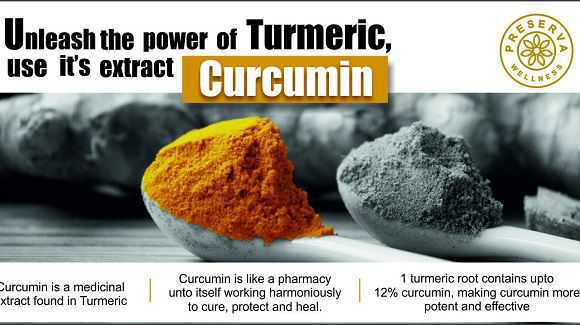Turmeric a bright yellow dietary spice from the ginger family has been used traditionally for thousands of years in India and China for therapeutic and culinary purposes. Advanced studies has shown and proved the worth of one of its strong key components known as Curcumin or Diferuloylmethane, which belongs to the group curcuminoids or bio-active polyphenols. It has countless medicinal benefits including lymphatic, respiratory, circulatory, reproductive, immunity, cardiovascular, neurological as well as cancer preventing. All these crucial therapeutic benefits are due to the single component Curcumin and its pleiotropic nature. Curcumin is a bioactive component of turmeric obtained from the dried rhizome of this extensively cultivated perennial herb found in Southeast Asia, India and China. A well known Indian spice, turmeric or Curcuma longa (family: Zingiberaceae), contains natural polyphenols collectively known as curcuminoids. While curcumin is the more potent component of curcuminoids compared to desmethoxycurcumin and bis-desmethoxycurcumin, all these impart yellow colour to turmeric, which has significant value in food additives and colorants. It is surprising to know that, the rhizome provides only 2% to 12% curcumin from an entire turmeric root.
Turmeric, curcuminoids and curcumin are entirely different things. Turmeric is a plant or herb, curcuminoids is a group of active poly-phenolic compounds found in turmeric rhizomes and curcumin is a small, potent more active natural chemical constituent of curcuminoids. Curcuminoids are a mixture of all the bio-active components of turmeric including curcumin, desmethoxycurcumin and bis-desmethoxycurcumin. Out of all these three, curcumin is more potent and imparts more therapeutic activities to the turmeric.
Few interesting things about Curcumin:
- Curcumin, a diphyniylheptanoid, belongs to the curcuminoids group, which are natural polyphenols. They exist in two isomeric forms, enol and keto, in which enol is more stable than keto form.

- Curcuminoids are polyphenols found within turmeric. They are composed of approximately 77% Curcumin.
- Curcuminoids are a tiny part or natural chemical constituents of the turmeric rhizome and the rhizome is just a part of the whole turmeric plant.
- Each of the components in curcuminoids has strong anti-oxidant and anti-inflammatory properties, but curcumin is the strongest.
- Turmeric and its bioactive components exhibit a few challenges such as poor bioavailability, quick metabolism and poor absorption. Hence commercial curcumin has been designed and developed to overcome these drawbacks and to provide maximum concentration after oral administration to get the desired therapeutic health benefits.
- Curcumin shows a potent cancer chemotherapeutic and chemopreventive property such as hindering abnormal cell cycle and apoptosis which helps in fighting cancer. It also has a great therapeutic role in managing Alzheimer’s disease and Inflammatory bowel disease.
- Curcumin also shows platelets-inhibitory, antipyretic and analgesic activity by inhibiting cyclooxygenase and blocking the synthesis of certain prostaglandins that are mainly responsible for the inflammation and pain. Hence it helps in reducing fever, pain and inflammation in the body.
- The unique chemical structure of curcumin along with potent biological, physical and chemical activities is mainly responsible for all the therapeutic benefits.
Difference Between Raw Turmeric and Curcumin Supplement:
As we are already aware that raw turmeric contains a very small amount of active Curcumin, to harvest the benefits of turmeric one needs to consume high quantities of raw turmeric powder. This is very tough and almost impossible to consume due to its bitter and astringent taste and also due to quantity. Moreover, it needs to retain its essential oils to give therapeutic benefits which may get destroyed while cooking as only flavour and aroma is left during the cooking process. Thus, it is better to get an extracted and pure curcumin form, which is designed in such a way that it provides a targeted and quick effect in comparison to raw turmeric. A quality curcumin supplement gets absorbed faster and is in a pleasant-tasting form which can be consumed in small quantities to get the desired result and to maximise the amount of curcuminoids.
Thus, it is better to get an extracted and pure curcumin form, which is designed in such a way that it provides a targeted and quick effect in comparison to raw turmeric. A quality curcumin supplement gets absorbed faster and is in a pleasant-tasting form which can be consumed in small quantities to get the desired result and to maximise the amount of curcuminoids.
 Thus, it is better to get an extracted and pure curcumin form, which is designed in such a way that it provides a targeted and quick effect in comparison to raw turmeric. A quality curcumin supplement gets absorbed faster and is in a pleasant-tasting form which can be consumed in small quantities to get the desired result and to maximise the amount of curcuminoids.
Thus, it is better to get an extracted and pure curcumin form, which is designed in such a way that it provides a targeted and quick effect in comparison to raw turmeric. A quality curcumin supplement gets absorbed faster and is in a pleasant-tasting form which can be consumed in small quantities to get the desired result and to maximise the amount of curcuminoids. The second important argument in favour of Curcumin is that it works as a natural medicine extracted from the rhizomes of the turmeric plant which contains only 2-12% curcumin. A very large quantity would be required to get the benefits of curcumin compared to the standardized form.
Curcumin Supplement is Better than Raw Turmeric because:
- Supplements have higher bio-availability compared to raw turmeric which make them more potent.
- Supplements are more easily absorbed form.
- Such formulations are easily dissolvable in fats such as milk as well as water.
- It is in the right dosage and optimum quantity to get the desired health benefits.
- Easy to consume and time saving, compared to adding turmeric in cooking or milk every time.
- More acceptable taste in comparison to raw turmeric.






